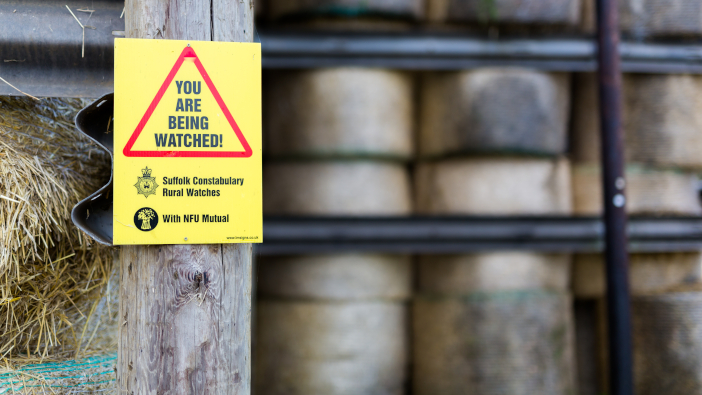After two years of declining rural crime figures during the Covid-19 pandemic, the start of 2022 has seen a sharp rise as the cost of living crisis impacts the countryside.
Rural insurer NFU Mutual has today published its 2022 Rural Crime Report, which shows a 40% increase in rural crime costs compared to the same period last year. The total cost of rural theft was estimated to be £40.5 million across the UK last year.
However, the report states that the cost of rural crime has risen more than 40% in the first quarter of 2022.
Signs that criminals were making a return started to show at the end of 2021. High-value machinery was targeted, with the cost of these thefts totalling more than £9 million last year. Land Rover Defender owners saw their vehicles under increased risk as the value of second-hand cars and replacement parts rose, with the cost of the claims shooting up by 87% to £2.6 million.

Thefts of ATVs fell, with the cost of claims dropping 11% to £2.2 million in 2021. However, the report states that almost half of these took place between September and December. Shipping delays and the combined effects of Covid and Brexit contributed to low supply and a rise in demand, leading to thieves taking units from farmyards.
Rustling also become more lucrative, with the latest analysis showing that animals worth an estimated £2.4 million were stolen in 2021. Soaring food prices mean that livestock thefts could increase further, raising concerns about food security, animal welfare and people’s health due to stolen animals being slaughtered in unhygienic conditions.
The number of fuel theft claims received by the insurer fell from 2020 to 2021 but with record prices of diesel and heating oil, the NFU Mutual claims data from the first half of 2022 indicates that fuel theft claims have more than doubled compared to the same period in 2021. In a new poll, 49% of respondents said that fuel theft was now their greatest crime concern.
The latest wave of rural crime has prompted the insurer to issue urgent advice, including a series of videos to help farmers take action.
Rebecca Davidson, rural affairs specialist at NFU Mutual, said: “Our latest claims figures warn that rural theft is quickly gathering momentum as criminals make up for time lost over the past two pandemic years. We’re advising rural people to review their security, to help prevent crime and disruption.
“With prices of essential farm equipment such as tractors and quads rising fast and the cost of diesel soaring over the past year, there’s little doubt that criminals will be trying to steal from farms. We also know that essentials of rural living like heating oil tanks will only become more attractive to thieves as costs rise. A recent poll by NFU Mutual reveals that 89% of respondents believe inflation will lead to an increase in rural crime.
“Crime in the countryside causes high levels of anxiety and disruption, with many farmers and rural homeowners feeling vulnerable due to their isolated location. The knowledge that determined thieves are scouring the countryside looking for targets, and returning to carry out night-time raids can lead to sleepless nights for people in remote areas.
“NFU Mutual is responding by helping those living and working in rural areas to put in place effective security measures and by continuing to provide major support to enable dedicated police resources to tackle crime.”
Last year, NFU Mutual invested £430,000 in rural crime initiatives. This included support for an agricultural vehicle theft unit at the National Vehicle Crime Intelligence Service (NaVCIS). This recovered stolen vehicles and machinery worth £2.6 million last year, as well as delivering intelligence and training, and working with police forces across the country and internationally.
Following the investment in NaVCIS and one-off grants to help police tackle GPS thefts, the cost of this crime fell by almost half in 2021 to £1.5 million.
Ms Davidson added: “As each farm or home is different, every property needs a different approach to keeping thieves out – and there’s an armoury of measures to help do so, from traditional fortification to technology using movement sensors, to community information networks.”
Rural theft costs by area
| Region or country | Cost in 2021 | Cost in 2020 | % change from 2020 |
| East | £5.1m | £6.6m | -22.4% |
| Midlands | £8.4m | £8.3m | +1.7% |
| North East | £6.7m | £8m | -15.4% |
| North West | £2.8m | £3.8m | -25.3% |
| Northern Ireland | £1.7m | £2.1m | -18.7% |
| Scotland | £2.6m | £1.7m | +52.3% |
| South East | £7.5m | £7.4m | +1.1% |
| South West | £4.3m | £5.3m | -18% |
| Wales | £1.3m | £1.6m | -17% |
| Grand Total | £40.5m | £44.7m | -9.3% |
Worst affected counties by cost
| Rank | County | 2021 | 2020 | % change from 2020 |
| 1 | Lincolnshire | £2,406,760 | £2,545,570 | -5.5% |
| 2 | Essex | £1,651,877 | £1,683,052 | -1.9% |
| 3 | Kent | £1,382,426 | £1,445,717 | -4.4% |
| 4 | Leicestershire | £1,235,802 | £1,244,881 | -0.7% |
| 5 | Suffolk | £1,178,428 | £1,470,057 | -19.8% |
| 6 | Gloucestershire | £1,162,932 | £1,162,675 | 0% |
| 7 | Lancashire | £1,134,391 | £1,484,103 | -23.6% |
| 8 | Hampshire | £1,129,631 | £1,305,965 | -13.5% |
| 9 | Warwickshire | £1,121,075 | £1,170,073 | -4.2% |
| 10 | Shropshire | £996,283 | £1,338,843 | -25.6% |


